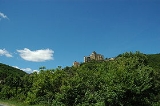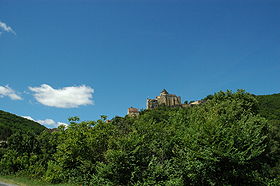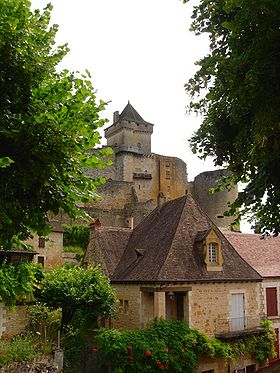
Château de Castelnaud-la-Chapelle
Encyclopedia


Castelnaud-la-Chapelle
Castelnaud-la-Chapelle is a commune in the Dordogne department in Aquitaine in southwestern France.The Château de Castelnaud-la-Chapelle is located in the commune.-Geography:...
, overlooking the Dordogne River
Dordogne River
The Dordogne is a river in south-central and southwest France.-Name:Contrary to appearances, the name of the Dordogne is not a recent word resulting from the names of the Dore and the Dogne...
in Périgord
Périgord
The Périgord is a former province of France, which corresponds roughly to the current Dordogne département, now forming the northern part of the Aquitaine région. It is divided into four regions, the Périgord Noir , the Périgord Blanc , the Périgord Vert and the Périgord Pourpre...
, southern France. It was erected to face its rival, the Château de Beynac
Château de Beynac
The Château de Beynac is a castle situated in the commune of Beynac-et-Cazenac, in the Dordogne département of France. The castle is one of the best-preserved and best-known in the region....
.
History
The oldest documents mentioning it date to the 13th century, when it figured in the Albigensian CrusadeAlbigensian Crusade
The Albigensian Crusade or Cathar Crusade was a 20-year military campaign initiated by the Catholic Church to eliminate Catharism in Languedoc...
; its Cathar
Cathar
Catharism was a name given to a Christian religious sect with dualistic and gnostic elements that appeared in the Languedoc region of France and other parts of Europe in the 11th century and flourished in the 12th and 13th centuries...
castellan was Bernard de Casnac. Simon de Montfort
Simon de Montfort, 5th Earl of Leicester
Simon IV de Montfort, Seigneur de Montfort-l'Amaury, 5th Earl of Leicester , also known as Simon de Montfort the elder, was a French nobleman who took part in the Fourth Crusade and was a prominent leader of the Albigensian Crusade...
took the castle and installed a garrison; when it was retaken by Bernard, he hanged them all. During the Hundred Years' War
Hundred Years' War
The Hundred Years' War was a series of separate wars waged from 1337 to 1453 by the House of Valois and the House of Plantagenet, also known as the House of Anjou, for the French throne, which had become vacant upon the extinction of the senior Capetian line of French kings...
, the castellans of Castelnaud owed their allegiance to the Plantagenets, the sieurs de Beynac across the river, to the king of France. In later times it was abandoned bit by bit, until by the French Revolution
French Revolution
The French Revolution , sometimes distinguished as the 'Great French Revolution' , was a period of radical social and political upheaval in France and Europe. The absolute monarchy that had ruled France for centuries collapsed in three years...
it was a ruin.
The château today
Today the picturesquely restored château, a private property open to the public, houses a much-visited museum of medieval warfareMedieval warfare
Medieval warfare is the warfare of the Middle Ages. In Europe, technological, cultural, and social developments had forced a dramatic transformation in the character of warfare from antiquity, changing military tactics and the role of cavalry and artillery...
, featuring reconstructions of siege engine
Siege engine
A siege engine is a device that is designed to break or circumvent city walls and other fortifications in siege warfare. Some have been operated close to the fortifications, while others have been used to attack from a distance. From antiquity, siege engines were constructed largely of wood and...
s, mangonneaux, and trebuchet
Trebuchet
A trebuchet is a siege engine that was employed in the Middle Ages. It is sometimes called a "counterweight trebuchet" or "counterpoise trebuchet" in order to distinguish it from an earlier weapon that has come to be called the "traction trebuchet", the original version with pulling men instead of...
s. The castle is listed as a monument historique
Monument historique
A monument historique is a National Heritage Site of France. It also refers to a state procedure in France by which national heritage protection is extended to a building or a specific part of a building, a collection of buildings, or gardens, bridges, and other structures, because of their...
by the French Ministry of Culture.

